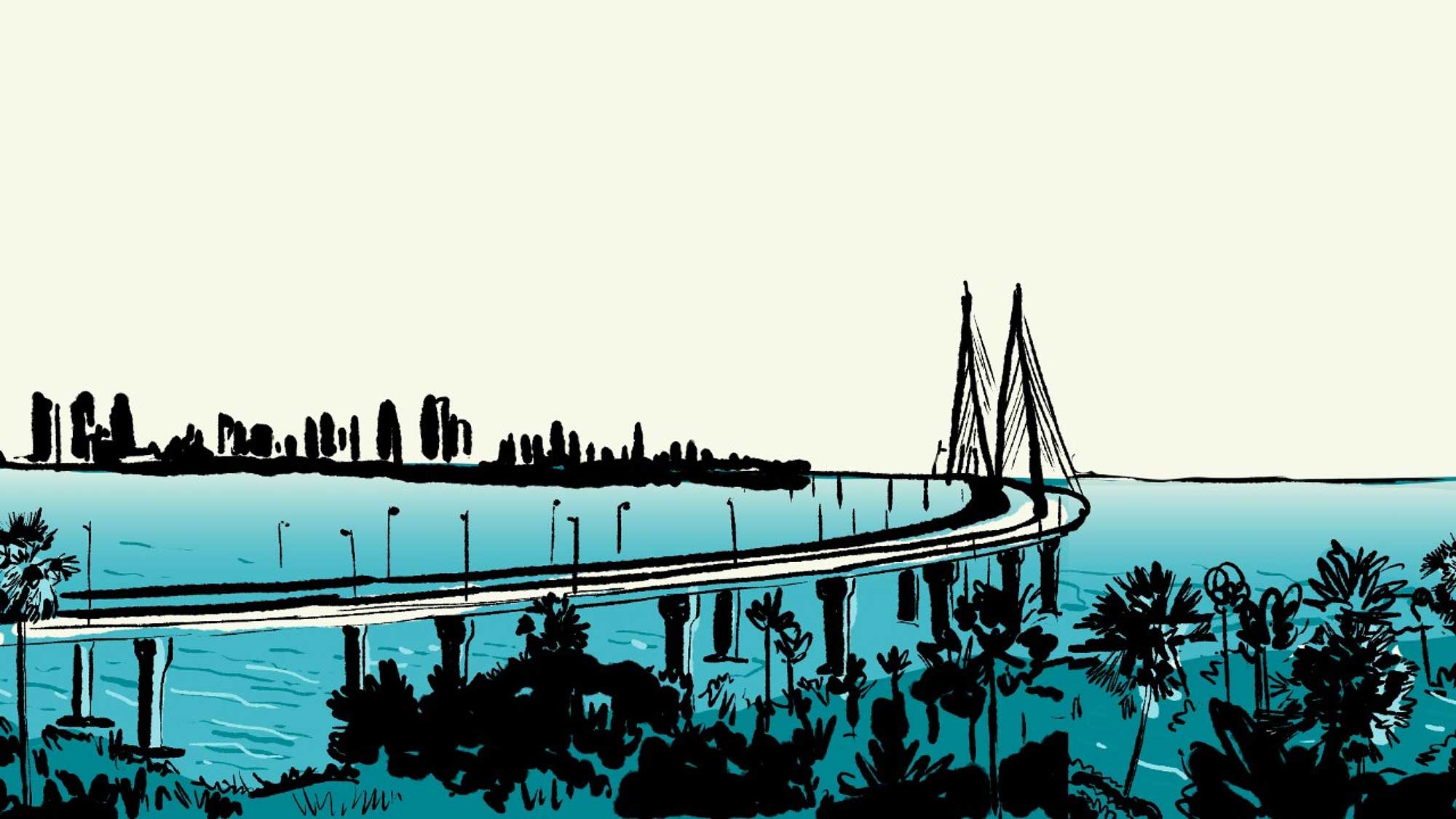Mumbai dust storms: A concoction of Mayanagari’s illegal hoardings, lack of proactive actions by authorities, the city’s surging temperature and the need for better weather forecasting departments.

Over the last week, violent dust storms have blasted across Mumbai, killing over a dozen people. A billboard fell in Ghatkopar, Mumbai, on Monday, killing 14 people, and 74 others were injured. The location had strong winds of 80-90 kmph, followed by thunder and light rain. The storm created interruptions for many people, including residents, commuters, and travellers.
The hoarding hurdle.
The roughly 100-foot-tall hoarding was apparently located adjacent to a petrol outlet on the Eastern Express Highway. The structure collapsed on victims who were refuelling their vehicles or seeking shelter at the petrol pump, according to reports.
The Indian Express claimed that a charge has been filed against Bhavesh Bhinde, the head of outdoor advertising business Ego Media, in connection with the fall of the enormous hoarding. Bhavesh Bhinde has been charged under sections 304 (culpable homicide not amounting to murder), 337 (causing harm to another person by acting rashly or negligently) and 338 (causing grievous hurt by act endangering the life or personal safety of others) of the Indian Penal Code. His company has been instructed to remove eight hoardings in the vicinity.
Maharashtra Chief Minister Eknath Shinde visited the scene of the event and provided an ex-gratia of Rs 5 lakh for the victims’ families. Shinde also ordered a structural audit of all hoardings in Mumbai and instructed officials to dismantle such buildings that were illegal or dangerous.
More such illegal structures in the ‘city of dreams’.
It has now been revealed that 99 of the 179 billboards on central (CR) and western railway (WR) land are exorbitant, prompting the civic authority to issue notifications to the railways to remove them – many in Bandra, Dadar, and prominent portions of the western suburbs – immediately. The Brihanmumbai Municipal Corporation (BMC) additionally employed the Disaster Management Act 2005 to push the railroads to act. The hoarding at Ghatkopar was placed on government property designated for the government railway police (GRP).

BMC discovered three more unauthorised billboards in the Chheda Nagar neighbourhood, the same place where Monday’s tragedy took place. Since Tuesday, efforts have been made to remove them using a comprehensive approach that includes wind speed analysis, traffic control, and available labour, all while minimising disruption to ongoing work at the accident site. Efforts are ongoing to deconstruct the billboards’ iron skeletons before their removal. The goal is to remove two billboards by Wednesday night, with a third to follow on Thursday.
Billboard and hoarding licencing generate around Rs 200 crore in revenue for the BMC each year. According to figures, the BMC charges around Rs 1.75 lakh/month for a 40×40 square feet structure. The permission does not come easily. The licence department, which analyses the advertisements placed on metal structures, demands no-objection certifications from several departments. The building and manufacturing department gives permits after conferring with other agencies such as the fire department, engineering and estate, among others. The garden department, soil testing, and tree authority all work to keep the flora undamaged. The agreement is for one year and includes a set deposit and rental charge.
The history of neglecting illegal hoardings in Mayanagri.
According to reports, both the authorities and the applicants ignore the renewal process after installing the hoarding. Following the Ghatkopar incident recently, the BMC, Railways and Government Railway Police (GRP) engaged in a blame game, with the municipal body quickly pointing out that the hoarding was on railway grounds. The railways said it was not their territory.
This is another disadvantage for applicants because the BMC guidelines do not apply to railway land. Furthermore, two weeks ago, the BMC issued a letter to the GRP and filed a police report, alleging that trees were poisoned to erect the hoarding. According to a statement from the GRP, the process of removing hoardings began after the BMC gave them a notice last week. Despite violating the size and tree regulations, the hoarding remained in the middle of a duststorm on Monday.
Last year, the Bombay High Court criticised the Maharashtra government for failing to take action against illegal hoardings and banners. The court stated that the residents of Mumbai wanted hoardings removed because they defaced the city and created impediments. The statement occurred during a hearing on allegations of non-compliance with the court’s 2017 orders to remove illegal hoardings. The high court further ordered the BMC to follow a Government Resolution (GR) issued by the state, which said that a hoarding or banner should have a QR code with the name of the person to whom permission is granted and the duration for which it is provided.
Could the lives lost when the billboard crashed into them in Ghatkopar during a dust storm on Monday have been saved? Yes, if the authorities had carried out the essential inspections following two similar events in adjacent Pune — one last month, which thankfully resulted in no injuries, and another last year, which resulted in five deaths. Last year, a Ghatkopar resident reminded them about the 2017 Pune tragedy, which claimed the lives of five people.
Salim Magbul Pathan, a Ghatkopar resident, wrote to the Brihanmumbai Municipal Corporation in August last year to express his worries over the hoardings. His letter went viral on social media on Tuesday. He was informed that it was under the authority of the Government Railway Police (GRP). The GRP did not follow up on his complaint.

The billboard that fell was 120×120 sq ft, which exceeds the maximum allowable size of 40×40 sq ft. In December 2023, after being under the civic scanner for a year, the BMC’s tree department filed a complaint with the police against Ego Media for breaking procedures. It had again sought the police for action number two weeks ago in April.
By now, you might be thinking that all the problems that resulted in the collapse of billboards and preventions on same could save the lives of Mumbaikars. But, wait, we are still on the way to discovering the bigger cause- the reason for dust storms, their impact on climate change and how it could affect the life of Mumbaians.
The Dynamics of Mumbai’s Dust Storms
Dust storms in Mumbai are the result of a complicated interaction between natural occurrences and human activity. A combination of these elements gives light on the dynamics influencing the city’s atmospheric landscape. So, it’s not only the nature, but the behaviour of Human that is the reason of such strong dust storms in the city.
Primarily, Mumbai’s dry and hot environment during the summer months gives ideal ground for dust storms to thrive. The arid air, exacerbated by rising temperatures, creates the conditions for a tornado of dust and debris. The evolution of urban sprawl has played an important role. Deforestation and fast urbanisation have robbed Mumbai of its green cover, exposing soils to erosion. As a result, even mild gusts can send dust particles into a frenzy. Industrial and construction activities contribute significantly to dust accumulation.
Factory and construction sites emit particulate pollution, which combines with natural factors, worsening the problem during windy times. Agricultural techniques in the surrounding areas, particularly tilling and dry farming, add to the aerial ballet of dust. These processes disrupt soil equilibrium, releasing particles into the atmosphere.

Geographical complexities pervade this story. Mumbai’s susceptibility is heightened by its closeness to the Arabian Sea and neighbouring desert regions—sand and dust-laden winds making their way from faraway locations to meet Mumbai’s skyline. Topographical peculiarities offer an extra depth. Low-lying pockets and dust buildup zones exacerbate the storm’s ferocity, prolonging its turbulent path. Understanding these complex causes reveals opportunities for action. Sustainable urban design, reforestation programmes, and severe industrial emissions rules provide opportunities to moderate Mumbai’s dusty dalliances.
The key question is, is there a relationship between climate change and dust storms?
The research implies that climate change can affect the frequency and intensity of dust storms. Global climatic fluctuations throw a long shadow and contribute to dust storms. Changes in bigger weather patterns might have an impact on Mumbai’s atmospheric cycle, exacerbating the dust storm situation. Changes in temperature and forecasting patterns can have an impact on soil moisture levels and plant cover, making soils more susceptible to erosion. Warmer temperatures can worsen drought conditions in particular areas, rendering drier soils more vulnerable to wind erosion during strong gusts.
Furthermore, climate change can affect air circulation patterns, thereby adding to the formation and spread of dust storms across wide areas. Changes in the position and intensity of weather systems, such as high-pressure systems and monsoons, can have an impact on wind patterns and dust transport paths.
Climate change can worsen land degradation processes such as deforestation, overgrazing, and unsustainable land management practices, hence increasing the availability of loose soil particles for wind erosion. Overall, while individual dust storms cannot be directly linked to climate change, the underlying environmental changes caused by climate change might contribute to conditions that promote the incidence and intensity of dust storms.
Now, if actions against illegal hoardings have been considered, and changes have been made in the city of Mumbai to mitigate the actions of such natural events, is enough? The sure-shot answer is NO.
Staying informed remains critical. It is key to monitor weather forecasts and respond to local authority advisories. However, dust storms impacted not just Mumbai but also the national capital, and warnings were issued afterwards—why couldn’t they be forecast in time?
This is because our forecasting methods are still a long way from accurately predicting dust storms and establishing early warning systems. This is owing to dust storms’ confined and ephemeral character, as well as a dearth of Doppler radars capable of tracking the meteorological conditions that accompany them.
Dust storms are similar to thunderstorms, but they occur when the cloud’s base is higher from the ground and there is less moisture in the atmosphere. Extremely strong winds sweep dust and soil off the ground, and dust storms are relatively common in dry and semi-arid locations. Skymet Weather Forecasting’s Mahesh Palawat predicts dust storms in northwestern India, Delhi, and Punjab in April and May. “The dust storm in Mumbai, however, was a unique event because coastal locations do not typically encounter dust storms of this magnitude,” he noted.
The India Meteorological Department (IMD) did not fully predict the dust storms that hit Delhi and Mumbai; in fact, its emergency “nowcasts,” or short-term predictions, came in a little after the dust storm conditions had started in certain areas. The IMD did not anticipate dust storms with wind speeds over 80 kmph in the daily forecast news releases; instead, it only forecasted thunderstorms with winds between 30 and 40 kmph.

Dust storms are particularly harmful for both humans and livestock due to their high winds and increased abundance of dust particles in the air. Currently, the systems can predict dust storms only 2-3 hours in advance using IMD’s nowcasts, which are issued to alert citizens to any sudden changes in the weather, the intensity of which is indicated by colours — red for warning, orange for alert, yellow for watch, and green for no warning. Nowcasts rely on Doppler radar data to follow cumulonimbus clouds, which are thunderclouds that generate rain, hail, and lightning due to convection.
According to IMD Director General M. Mohapatra, India is well-positioned to anticipate dust storms and their intensity. “Doppler radars and satellites are only used to monitor dust storms, but the authorities have prediction models in place to predict them as well,” Mohapatra explained. “Dust storms have a very limited life time of approximately 2-3 hours, which is why they can’t foresee them 7 or 10 days in advance,” he said.
Aside from Doppler radars, predicting these events has other obstacles. According to Rajeevan Nair, former secretary of the Ministry of Earth Sciences, dust storms are exceedingly localised and brief in length, making forecasting even more challenging.
The IMD’s press releases on May 8 and 10 projected thunderstorms, gusty winds, and lightning throughout Peninsular India, particularly Maharashtra’s Marathwada area, till May 12. It also predicted thunderstorms across Northwest India on May 10, when Delhi was pounded by a dust storm, but only for 30-40 kmph winds. However, Nair stated that this is the degree to which our technologies are capable of predicting such dust storms.
The IMD cannot anticipate dust storms with the same level of accuracy that they can predict cyclones or other wind activities. Most dust storms begin and end within a few hours, with no build-up that can be detect,” he stated. They can foresee the probability of dust and thunderstorms 24 hours in advance, but the system can’t guarantee when or where they’ll hit.”
According to a 2021 study titled ‘Sand and Dust Storm Risk Assessment in Asia and the Pacific’ by the Asian and Pacific Centre for the Development of Disaster Information Management, over 500 million people in India are exposed to poor air quality as a result of dust storms, and these storms are expected to increase as droughts in parts of Asia worsen due to climate change.
According to Mohapatra of the IMD, dust storms occur in most desert areas such as Iran and Afghanistan, and the one in Mumbai on May 13 was not uncommon. “The dust storm in Mumbai was accompanied by rain and thunder, both of which are traditional markers of a thunderstorm. This being the summer season, which is ideal for dust storms, and because Mumbai is a coastline city, there was certainly rain afterwards. Dry dust storms are more common in Delhi and Rajasthan, as observed last week,” Mohapatra explained.
Dr. Anjal Prakash, a clinical associate professor at the Indian School of Business, noted that dust storms are particularly dangerous to both humans and animals due to the risk of respiratory and cardiovascular ailments. “The abrasive quality of dust particles can irritate livestock’s eyes and skin, causing pain and decreased output. Dust storms may also pollute water and fodder supplies, jeopardising our health and well-being,” he explained.
He added that in the future, adjustments will be required not only in predicting dust storms, but also in their mitigation. “Preventing dust storms entails employing land management methods to prevent soil erosion, such as afforestation, ground cover, and windbreaks,” explained Prakash.
So, after what authorities do, whether in case of the action of illegal hoardings or the warning signals by the weather forecasting department, what can the Mumbaikars do to mitigate the catastrophic actions of these dust storms?
As dust storms sweep over Mumbai, it is critical to prioritise safety and mitigate the effects of these natural occurrences. These storms not only present acute risks, but they can also have long-term health consequences. It is critical to take some basic safeguards to protect persons and the community during such disasters.
First and foremost, people should take shelter inside on the evening of the warning. Shutting windows and doors creates a barrier against invading dust, so protecting interior air quality. Investing in air purifiers can strengthen this defence and provide a cleaner breathing environment. During severe storms, it is best to avoid needless travel because reduced visibility increases the danger of an accident. If going outside is inevitable, people should use masks to protect their respiratory systems from dangerous dust particles and safeguard their eyes with glasses to prevent irritation.




